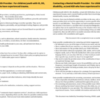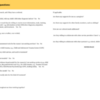Hi. I train a modified version of “The Road to Recovery: Supporting Children with Intellectual and Developmental Disabilities Who Have Experienced Trauma,” developed by the Hogg Foundation and the National Child Traumatic Stress Network (NCTSN). And while there is a story behind their development, I have drafted two documents; one of which, is the attached.
“For a child/youth with ID, DD, disability, or/and ASD who has experienced trauma. Some available information and tools for Mental Health providers,” is a work in progress, but useable in the state it is in. It was drafted with a dual purpose:
- To be made available to mental health providers as a stand-alone document.
- For caregivers and others to use, in conjunction with the other drafted document, “Contacting a Mental Health Provider: For children/youth with ID, DD, disability, or/and ASD who have experienced trauma.” (At this time, that document requires some level of training/understanding for utilization. I have attached pngs of it; and if you’re interested in the PDF, contact me.)
Hope this is of benefit. And of course, while I already know things that can make it better, if you have information or/and tools that should be added, let’s connect.




Comments (2)